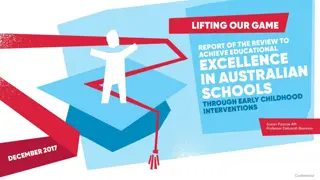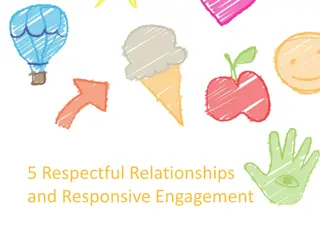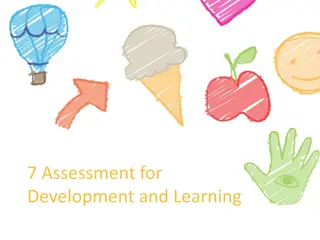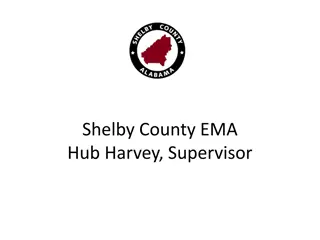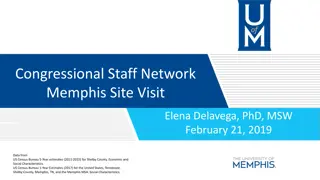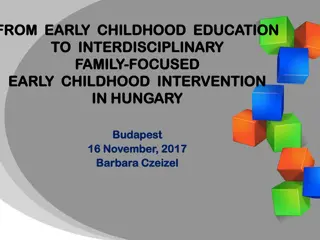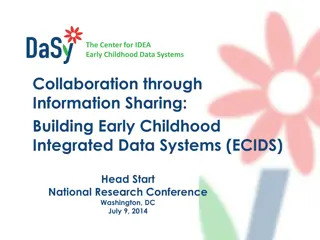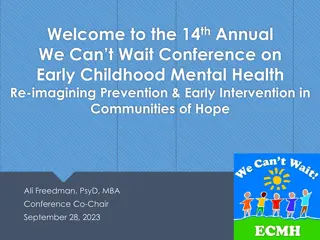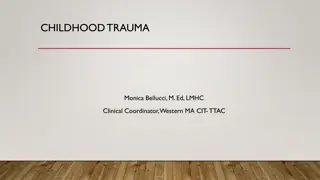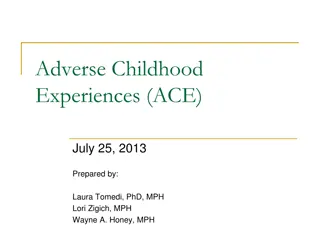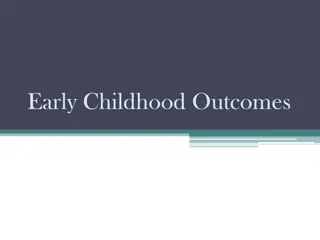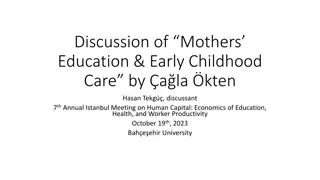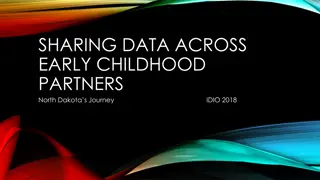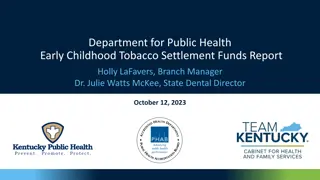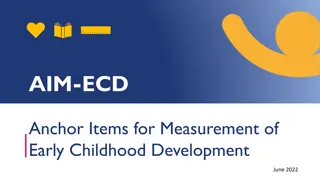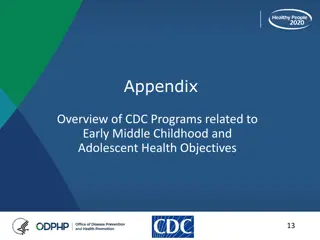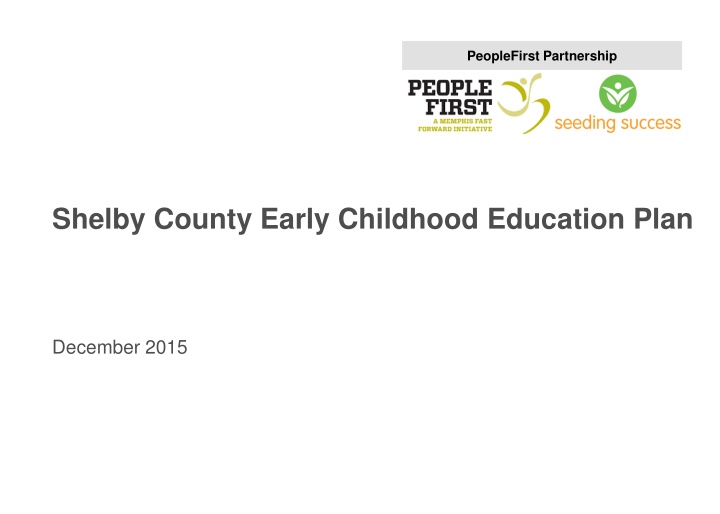
Improving Early Childhood Education in Shelby County: 2015 Plan Overview
Discover the comprehensive plan developed in 2015 by the PeopleFirst Partnership for enhancing early childhood education in Shelby County. The plan focuses on improving education from birth to the 3rd grade, with the aim of enhancing 3rd-grade proficiency. Learn about the collaborative efforts, strategies, and resources involved in this initiative.
Download Presentation

Please find below an Image/Link to download the presentation.
The content on the website is provided AS IS for your information and personal use only. It may not be sold, licensed, or shared on other websites without obtaining consent from the author. If you encounter any issues during the download, it is possible that the publisher has removed the file from their server.
You are allowed to download the files provided on this website for personal or commercial use, subject to the condition that they are used lawfully. All files are the property of their respective owners.
The content on the website is provided AS IS for your information and personal use only. It may not be sold, licensed, or shared on other websites without obtaining consent from the author.
E N D
Presentation Transcript
PeopleFirst Partnership Shelby County Early Childhood Education Plan December 2015
Context for this document This is a Plan for improving the state of early childhood (birth to 3rd grade) in Shelby County and was developed with the intent of building on existing efforts that are helping make progress and forming a set of recommendations that address the highest priority needs and gaps to ultimately improve 3rd grade proficiency in Shelby County. This Plan was developed by a consortium of public and private stakeholders in Shelby County from September to December 2015 with support from The Boston Consulting Group. BCG helped develop a fact-base, analyze the current state, and understand perspectives from experts and leaders in order to inform the set of recommendations included in this Plan. For any questions regarding this Plan, please contact Lora Jobe, the Executive Director of the PeopleFirst Partnership, at ljobe@peoplefirstpartnership.org 1
Objective and deliverables for this effort Statement of objective: All children and families in Shelby County receive the aligned, high-quality support they need from birth so that all children read on grade level by third grade 1 Common metrics and targets for Shelby County along the birth-to-third grade continuum (e.g., K readiness, third-grade reading) Will include common definitions of metrics that research indicates are the most important intermediate milestones on the way to third-grade literacy Purpose: both to inform strategy and to show progress over time Audiences: the public, educators and other service providers, and policymakers 2 A plan for enabling the ongoing measurement of these metrics over time Inventory of current data availability and gaps Recommendations for closing gaps and improving data capture and sharing. May include, for example, recommendations for improving data linkages across 0-3, PK, and K-3 providers 3 Map of service providers and stakeholders involved in delivery and support along the continuum 4 Analysis of Shelby County's birth to third grade current state Participation rates, performance/quality, inventory of current improvement efforts Strengths and gaps (e.g., capacity gaps, coordination gaps across operators) 5 Recommended strategies for addressing highest-priority gaps and opportunities Clearly identifying ownership of each strategy Mapping strategies' estimated costs and identifying current resourcing, gaps, and potential funding streams 6 Coalition of operators, support providers, community leaders, and funders aligned behind the plan and primed to support and monitor implementation progress 2
Shelby County ECE effort: process overview September mid-October mid-October - current Develop and refine recommendations and implementation plan Build fact-base Conduct one-on-one interviews with Steering Committee members and other local stakeholders Analyze current state data on participation, performance and quality Hold focus group with Kindergarten teachers in Shelby County Interview experts / leaders from other communities outside Shelby County Research emerging practices and models outside Shelby County Organize working sessions to gather input on highest-priority areas Review literature on best practices linked to student outcomes Draft recommendations based on highest- priority areas Receive feedback on recommendations from Steering Committee members and other stakeholders Conduct working sessions to gather input on recommendations from key stakeholders Prioritize recommendations and outline preliminary timeline Identify policy and funding implications of recommendations Propose team structure and ownership for implementation phase Secure Steering Committee endorsement of final plan Steering Committee meetings 9/4 9/23 10/21 11/4 12/18 Working sessions 10/13 10/13 10/14 12/17 11/11 3
Shelby County Early Childhood Steering Committee comprised of a diverse coalition of stakeholders... Sandra Allen,LeBonheur Children s Hospital/Early Success Coalition Malika Anderson, Achievement School District Jessica Ball, Hyde Family Foundations Jim Boyd, Pyramid Peak Foundation Kathy Buckman-Gibson, Chamber of Commerce/Chairman's Circle Kristi Ford, Bartlett City Schools Trina Gilliam, LeBonheur Children's Hospital/ Early Success Coalition Sandy Guntharp, Ready Set Grow/MAEYC Karen Harrell, Porter-Leath Joey Hassel, TN Department of Education Dr. Hank Herrod, The Urban Child Institute Martha Jackson, Jesse Mahan Child Care Center Jerri Jackson, Millington Municipal Schools Sean Lee, Porter-Leath Mayor Mark Luttrell, Shelby County Government Dr. Deanna McClendon, Shelby County Schools Katie McPherson, Achievement School District Misty Moody, TN Department of Education Dr. Mary Palmer, Southwest Tennessee Community College Chris Peck, ACE Foundation Dianne Polly, Shelby County Education Foundation Dr. Barbara Prescott, PeopleFirst Partnership Dr. Heidi Ramirez, Shelby County Schools Dr. Loretta Rudd, University of Memphis Channel Sallie, Shelby County Schools Mark Sturgis, Seeding Success Blair Taylor, Memphis Tomorrow Cathy Thompson, Achievement School District Paul Young, Shelby County Government Keisha Walker, Shelby County Government/Early Success Coalition Lora Jobe, PeopleFirst Partnership Cate Joyce, Seeding Success 4
...with further input from several additional experts, leaders, and other stakeholders in early childhood education Within Shelby County Within Tennessee Peter Abell, Books from Birth Michael Collins, Germanshire Elementary Shelly Counsell, University of Memphis ZB Davis, TFA Memphis Taylor DeMagistris, Teacher Town Tosha Downey, Teacher Town Betty Dupont, Hope House Nate Ferguson, Where We Live Mid-South Anasa Franklin, SCS Performance Management Rorie Harris, SCS Performance Management Sutton Mora Hayes, Where We Live Mid-South Dottie Jones, CoactionNet David Jordan, Agape Catherine Monaco, Impact America TN Bob Nardo, Libertas Alicia Norman, Perea School Jason Ogle, SCS Assessment and Accountability Lindsey Osborne, ,SCS Talent Acquisition Courtney Robertson, Knowledge Quest Principal Strickland, Manor Lake Elementary Mrs. Thomas, Joyland Academy Greg Thompson, Pyramid Peak Athena Turner, TFA Memphis Ashley Walton, SCS Talent Acquisition Elizabeth Wilson, TECTA Brian Wright, University of Memphis Connie Casha, Tennessee Dept of Education Katari Coleman, Dept of Human Services Misty Moody, Tennessee Dept of Education Gary Smith, Tennessee Dept of Education Lisa Wiltshire, Tennessee Dept of Education Outside Tennessee Julie Asher, Harvard University Susan Bales, Frameworks Institute Steve Barnett, NIEER Madeleine Bayard, Rodel Foundation of Delaware Charles Carter, Harvard University Alan Cohen, Dallas ISD Ann Cook, Salt Lake City Community Learning Center Kim Day, Drew Charter School Alex Hales, TFA Dallas Cynthia Kuhlman, CF Foundation Derek Little, Louisiana Dept of Education Jaime Meyers, Commit Jessica Pizarek, Policy Link Al Race, Harvard University Sara Remington, Rhode Island Dept of Health Julie Sweetland, Frameworks Institute Todd Williams, Commit 5
Early childhood plan targeted at improving access and quality along birth to 3rd grade continuum 0 3 yr olds 4 yr olds K 3rd grade Establish incentives to create more high quality seats in areas with unmet demand Strengthen child care certificate distribution Raise family and community awareness of value of early learning Increase capacity of high-quality pre-K programs Build ecosystem of wraparound and supplemental academic support providers in K 3rd 1 10 12 Access and awareness 2 3 Expand in home and unlicensed provider supports Increase usage of developmental screeners Improve referral conversion for home visitation Strengthen state QRIS Adopt a common definition of high quality pre-K Improve pre-K quality Mitigate summer learning loss Mentor and train schools to expand on-campus SEL supports Strengthen pre-service preparation through exposure to more relevant coursework and classroom experiences Enhance professional learning opportunities through more effective implementation of coaching, PLCs and PD Encourage district/school leadership to better align instructional practices and expectations across the pre-k to 3rd continuum 4 13 8 14 5 9 6 Quality 15 11 7 16 Adopt community-wide scorecard with measures across birth to 3rd 17 Adopt common assessment approach from birth to 3rd grade 18 Recruit and retain high quality early educators 19 Continuum Implement a holistic place-based model 20 Build data sharing infrastructure to coordinate services and inform action 21 Build analytic, research and continuous improvement capability 22 The PeopleFirst Partnership, as the backbone organization, to coordinate and oversee implementation of the Plan 23 6
0-3 year old recommendations (I) 1 Better understand neighborhood-specific supply and demand imbalances and provide incentives to enable more high quality seats where there is unmet demand Within neighborhoods selected for place-based pilots, better understand supply and demand, and barriers to enrollment for early childcare and develop tailored approaches to address significant barriers Once supply and demand imbalances are better understood, provide incentives for known high quality private providers to expand in high needs areas; Need to determine what types of incentives are most effective Continue to provide and look to expand professional development opportunities to existing centers through ESC's Professional Development Action Team, the SCS Early Care Academy, The Urban Child Institute, the Child Care Resource and Referral Center, and community-based PD centers Establish incentives to create more high quality early childcare seats in areas with unmet demand 2 Evaluate potential ways to strengthen childcare certificate distribution that increase affordability and accessibility for families, and measure whether accessibility is improving over time Consider a potential policy change that removes the per family 60 month certificate limit and modifies coverage to 60 months per child. Assess the economic impact and other implications of such a change, and accompany such a change with advocacy for increased funding for the Child Care Certificate Program Institute the ability to track whether accessibility is improving through county-wide tracking of the share of children aged 0-3 who qualify for certificates and are in seats (% uptake) and the share of children who are getting certificates and going to 4 or 5 star centers (measure of uptake of higher quality offerings) Strengthen child care certificate distribution 3 Raise awareness of the value of early learning and the importance of having high quality options Establish measurable goals for existing and new awareness building efforts and put in place accountability mechanisms to track progress and inform continuous improvement (consistent with recommendation 22) Continue to expand on existing awareness building efforts that prove to be effective in leading to increased family awareness and behavioral change related to early learning. Existing efforts include those led by the Early Success Coalition (K-Readiness Collaborative Action Network, Nurturing Parenting, Strengthening Families), The Urban Child Institute's 'Touch Talk Read Play' campaign, Universal Parenting Places, the Child Care Resource and Referral Center, and other efforts currently underway Provide recognition to and reward grassroots awareness building efforts that are particularly effective (e.g., Early Education Community Program of the Year). Consider promoting targeted awareness building campaigns in facilities frequently used by target populations (e.g. "Wash Time is Talk Time" campaign in laundromats which encourages parents to read to their children during idle time) and/or creating a mobile-based awareness campaign to deliver timely and relevant information (similar to Vroom in Dallas) Identify key community assets (trusted individuals), get their buy-in, and relay key messages through them Raise family and community awareness of value of early learning 7
0-3 year old recommendations (II) 4 Expand supports for families at home and for unlicensed centers Look for ways to extend or expand existing channels and training programs that are effective in reaching families in home and/or unlicensed centers (e.g., extend information on child care development through Books for Birth, expand trainings offered by Neighborhood Christian Center and ESC, expand training for Alternate Approval homes) Give families tips on developmentally appropriate everyday activities that they can do with their children to address each component of the PASS framework (physical, academic, social-emotional, and self-help). Tips can be distributed through physical calendars, paper handouts, and mobile applications like Vroom Create a competition for social entrepreneurs that provides incentives to find and pilot innovative grassroots models, evaluate what is working, and reward effective offerings that are based on research-informed practice Consider piloting Versame's Starling wearable technology that measures words spoken to a child as a way of accelerating child interactions at home; work with Versame to aggregate community-wide data on word exposure Expand in-home and unlicensed provider supports Increase the usage of screeners to identify developmental delays Recommend community-wide adoption of Ages and Stages as the 0-3 screener to identify developmental delays Advocate for adding screener use and provider follow-through as a requirement to obtain a higher QRIS rating which will be accompanied by higher reimbursement to offset the cost of the screener Continue existing efforts to increase screener usage among childcare and early home visitation providers, SCS Head Start Family Support Specialists, parents and pediatricians through ESC's Project Launch as well as training offered by the TN Academy of Pediatricians Replicate the Impact America-TN direct-push model currently being used for vision screening to support increased usage of the Ages and Stages screener [AmeriCorps volunteers can help train parents to conduct the screenings, provide developmentally appropriate activities to do with their children, and refer parents to the TN Early Intervention System (TEIS) for follow-up] Advocate for additional funding and support for TEIS to administer early intervention services to more children (from current Shelby County rate of 1.4% of children to TN projected target of 2.4%) For consideration in longer-term: increase coverage of special education to children who were supported by TEIS, but do not qualify for special education under the school system (~200 children a year based on 2007 TEIS study) 5 Increase usage of developmental screeners 8
0-3 year old recommendations (III) 6 Improve awareness and referral conversion for home visitation seats and gradually ramp-up capacity Expand existing efforts to increase awareness and improve referral conversion (e.g. ESC specialists, faith- based outreach, local health fairs); Expand resources to conduct deeper analysis of barriers to referral conversion and resources to make and track ESC referrals Expand resources to gradually ramp-up capacity to support more home visitation spots through recruiting and training of staff Analyze barriers to referral conversions (e.g. transience, distrust, stigma) and refine current strategies Advocate for funding to ensure existing spots remain (e.g. Department of Health funding for Health Families Program) Improve referral conversion for home visitation Support and advocate for strengthening Tennessee's QRIS system Advocate for a 4 or 5 star system under Department of Human Services (DHS) with higher stars tied to learning outcomes; use of research-informed curriculum, assessments and screeners; and hiring of staff with more training Provide higher reimbursement for higher ratings with the following guidelines: Within 3 years, any remaining unrated or 0 star programs will receive a discounted reimbursement rate Create a sloped curve of increased reimbursements with smaller increases up to 3 stars, followed by larger increases for 4 and 5 stars Set specific reimbursement rates with an understanding of the value of each star rating and the cost to deliver against those requirements (e.g. compensation of higher credentialed staff) Establish a longitudinal study to evaluate the outcomes of children who are in licensed vs unlicensed centers and over time inform potential accountability measure that all publically funded early childcare education centers have to be licensed (if licensed pathway delivers better outcomes for children over time) Support the Department of Education's (DOE) creation of an assessment which will incorporate measures of quality to track providers licensed by DOE Build greater public awareness of the QRIS ratings and DOE assessments so that the ratings are transparent for parents to use in their choices of providers and locations 7 Strengthen state QRIS 9
4-year old recommendations (I) 8 Define kindergarten-readiness and identify what elements constitute a high quality pre-K offering Collaborate with the state on efforts to create a multi-dimensional definition and measure of k-readiness that includes academic and social-emotional elements, through local participation in the state's ECE council. In implementing the K-readiness assessment, state and local leaders should consider total time spent delivering assessments and minimize use of duplicative instruments Adopt new state definition and assessment as the standard for k-readiness in Shelby County starting in the 2016-17 school year Translate common definition of k-readiness to inform pre-K offering including curriculum, wraparounds, and other interventions Adopt a common definition of high quality pre-K 9 Continue to focus on improving the quality of existing pre-K seats in Shelby County Modify teacher evaluation policy in pre-K through 3rd grade to incorporate both students' academic and social- emotional measures. Add student growth as an input in TEM (or other relevant) evaluation. Before the 2016-17 school year, may need to use existing measures (e.g., BRIGANCE) to capture SEL growth Utilize teacher evaluation instrument (CLASS or a similar tool) to give targeted feedback on teacher-student interactions and inform professional development needs in an effort to improve teacher's instructional practice. Pre-k-2nd grade addendum to TEM evaluation can continue to be used in SCS in addition to CLASS (or similar tool), but CLASS (or similar tool) should be a focus given research base and existing use In schools with onsite pre-K, improve alignment between pre-K and K-3rd grade through use of aligned assessments and more vertical and joint planning sessions In schools with offsite pre-K, encourage more joint planning time between leaders and teachers in pre-K classrooms with feeder Kindergarten schools Apply select 0-3 year old, K-3rd grade, and continuum recommendations to 4-year olds: raise family and community awareness of value of early learning, enhance professional learning opportunities, build pipeline of early educators Improve pre-K quality 10 Grow additional curriculum-based pre-K seats in high quality programs In zip codes where demand exceeds available high quality space for pre-K seats, develop a facilities master plan across school-based, community partner, and private sites to find more physical space; preferentially build out more onsite pre-K where space is available to facilitate alignment with K-3rd Analyze population trends and areas in most need of additional pre-K capacity, understand where high quality pre-K programs currently exist, and then identify funding to expand successful models in areas with most need Increase capacity of high quality pre- K programs 10
4-year old recommendations (II) 11 Build capacity for summer programming to mitigate summer learning loss and measure impact to ensure programming is effective Scale evidence-based quality summer programs through external providers and school districts by hiring and training more staff (e.g., expanding Seeding Success' pilot using the Reading A to Z program, continuing to collect real-time attendance and student engagement data so providers can make timely interventions) Build systematic and coordinated process for referring children into high quality summer programs. Providers should understand needs of students to inform types of programs and capacity building required During summer pilot, measure the impact of summer programming with an assessment independent of the product/curriculum used for summer instruction to ensure that gains will contribute to driving 3rd grade proficiency Mitigate summer learning loss 11
K-3rd grade recommendations (I) 12 Build an ecosystem of wraparound and supplemental academic support providers in K-3rd grade by growing capacity of providers and partners Seeding Success to continue analyzing student performance data to identify largest areas of need and what types of wraparound services can be most effective in addressing academic and social emotional needs Expand partnerships with organizations (including the Alliance for Nonprofit Excellence, the Chamber, and Seeding Success) that can offer training to providers on how to become more efficient and effective and grow capacity Help existing providers attract and train staff to scale-up, and separately, recruit new providers to increase overall capacity in Shelby County particularly around services that are in highest need; Seeding Success to continue to play role of helping providers understand the needs of districts/operators and develop more integrated service offerings Consider a pilot extension of the family service staff model in pre-K into K-3rd to deepen parental engagement Build ecosystem of wraparound and supplemental academic support providers in K-3rd 13 Expand in-school social-emotional learning (SEL) models through collaboration and mentorship Develop an understanding of SEL models embedded in existing curriculum that have worked effectively in Shelby County classrooms (e.g., select ASD operators who are integrating SEL into the curriculum) Create forum for district-charter school collaboration so school leaders and teachers have opportunities to engage in best practice sharing and classroom observation in schools with SEL integrated into the curriculum Mentor and train schools to expand on-campus SEL supports 14 Strengthen pre-service preparation in key areas, including literacy foundations and early childhood development, through more classroom experience, relevant coursework, neighborhood exposure, and increased accountability Support expansion of existing alternate teacher training programs with strong performance track records (major programs include Teach For America-Memphis and Memphis Teacher Residency) to attract talent to the teaching profession in Memphis Expand current Report Card on the Effectiveness of Teacher Training Programs (published by the Tennessee Higher Education Commission) to include metrics related to teacher qualifications and performance Re-shape core teacher prep curriculum to provide students with real classroom experience, targeted professional development on how to teach a more diverse set of children, coursework on how to effectively use formative assessments to inform instructional practice and small group instruction, coursework with depth on literacy foundation knowledge, exposure to communities and neighborhoods to provide teacher candidates with appropriate context for understanding student backgrounds. Consider developing a mechanism to centrally track candidates who have completed these requirements Strengthen pre- service preparation through exposure to more relevant coursework and classroom experiences 12
K-3rd grade recommendations (II) 15 Enhance professional learning opportunities through more effective deployment of instructional coaches and more robust implementation of professional learning communities (PLCs) with a focus on building early literacy foundational content knowledge and effective pedagogy Continue existing district efforts to strengthen deployment of coaches through rigorous selection and training processes, clear role definition for coaches that is supported by principals, and hands-on modeling. Shift mix of coaches over time to improve quality by measuring improvements in aggregate learning outcomes for the teachers that coaches are supporting (need to define what degree of improvement in literacy proficiency for students qualifies as high quality coaching) Determine optimal ratio of coaches over time by testing effectiveness of different coach to teacher ratios and analyzing student growth associated with those groups Implement PLCs and vertical planning meetings infused with right content and facilitation by fostering a culture of trust where teachers feel safe to openly discuss classroom challenges; instituting meetings with clear structure and purpose that focus on pressing challenges in the classroom; committing to a continuous improvement approach; and selecting skilled facilitators who are respected by teachers and promote action- oriented discussions Enhance professional learning opportunities through more effective implementation of coaching, PLCs and PD 16 Encourage district and school leadership to focus on creating more alignment of curriculum, instructional practices, and student expectations across pre-K to 3rd grade Develop district leadership structures that focus on pre-K to 2nd (for example, SCS instructional advisors already covering multiple early grades in 2015-16 school year) Improve alignment between pre-K to 3rd grade through more vertical and joint planning sessions so teachers can coordinate instructional practices such that students have seamless transitions from grade to grade Increase weighting on K to 2nd grade performance during school evaluation process so teachers/leaders are incentivized to focus on early grades (e.g., place meaningful weight on 2nd grade assessment results during school evaluation process; can adopt 2nd grade assessment that the state is currently developing) Encourage district and school leadership to better align instructional practices and expectations across pre- K to 3rd 13
Continuum recommendations (I) Adopt a community-wide scorecard with academic and whole-child indicators along the birth to 3rd grade continuum Align on a common set of metrics across the continuum related to health, social-emotional, and academic dimensions that contribute to 3rd grade literacy, are measurable, and comprehensively capture the current state of and aspiration for early childhood education in Shelby County. Build on the ESC 0-3 dashboard and Seeding Success pre-K through 3 metrics to inform the metrics Establish a clear pathway for how the initiatives under the plan and other broader efforts in Shelby County contribute to making progress against the metrics that are ultimately selected Expand current PeopleFirst Partnership scorecard to incorporate metrics adopted by this consortium Partner with the Community Foundation's Where We Live Mid-South effort to ensure early childhood scorecard metrics are a subset of the larger community indicator set 17 Adopt community- wide scorecard with measures across birth to 3rd Adopt a common assessment approach from birth to 3rd grade for Shelby County Select and commit to a common multidimensional assessment / screener for birth to age 3 (recommend Ages and Stages) for childcare, early home visitation and pediatrician stakeholder groups, and build on ESC infrastructure to incentivize large-scale adoption throughout Shelby County. As a principle, the adopted instrument should be kept consistent for a minimum of five years before revisiting its suitability Adopt the statewide Kindergarten readiness assessment. In parallel, each district/operator should evaluate opportunities to eliminate other assessments (where the statewide assessment provides similar data) in an effort to avoid excessive testing For K-3rd, adopt a set of guiding principles county-wide that encourage use of assessments that are aligned, are early predictors of 3rd grade literacy, and are held consistent over a multi-year timeframe Adopt common assessment approach from birth to 3rd grade 18 Recruit and retain high quality early educators in Shelby County For 0-4 year olds: Require 4 and 5 star centers to have 60% and 80% of their staff, respectively, hold a CDA or higher credential Increase reimbursements for 4 and 5 star centers such that centers can afford to pay employees with CDAs $12 per hour or more (to recognize the value of the CDA and encourage others to pursue it) Conduct a longitudinal study of children 0-4 years old with exposure to instructors with various levels of training to determine the (a) impact of instructor training on kindergarten readiness, (b) instructor training level necessary to drive learning outcomes, and (c) suggested mix of training levels required for each star-rating [if necessary, adjust requirements tied to star ratings to be consistent with findings from longitudinal study] Increase capacity of training programs (e.g., TECTA, state efforts) to manage growing demand for certification resulting from new policies Recruit and retain high quality early educators 19 14
Continuum recommendations (II) Recruit and retain high quality early educators in Shelby County For preK-3rd: Expand on existing efforts like Teacher Town that are facilitating the branding of Memphis as a desirable location for teachers and principals Attract local talent into the profession early by introducing programs and scholarships that expose high school students to the teaching profession early (e.g., Teacher Cadet Program) and potentially fund college education costs contingent on candidates returning to Shelby County to teach (e.g., Golden Apple Scholarship) Develop teacher leader roles to allow skilled teachers to take on more responsibility, support school leadership, and receive more compensation as a retention strategy via district-run programs and/or partnerships (e.g, Leading Educators) Continue to align compensation for pre-K teachers across all curriculum-based programs (e.g., Head Start, VPK) Both: Recognize, celebrate, and learn from excellent teachers so high-performers are and feel respected and, expectations and examples are widely communicated Recruit and retain high quality early educators (continued) 19 Develop and implement a holistic place-based model that establishes and integrates the following elements within a neighborhood Align curriculum and pedagogy: Leadership from early childcare education centers and school districts collaborate on how to better align curriculum, teacher planning (more vertical and joint planning sessions), and family engagement and expectation setting as children progress through continuum Build capacity to provide professional development to early educators from both public and private schools/centers (e.g., extend SCS Early Learning Academy to provide PD for a cohort of early childcare administrators) Raise awareness and provide direct supports to families through coherent and coordinated set of efforts: Continue investing in existing effective efforts, and incent grassroots pilots that more effectively provide in-home supports (e.g., mobile push messaging with tips on how parents should interact with their children) Understand demand and increasing the number of higher quality providers: Understand what barriers families face in enrolling their children in high quality early child care, test targeted solutions to address those barriers, and increase the number of high quality providers seats over time Enablers to drive place-based model: a single lead organization to establish goals and roles, oversee progress, and capture lessons learned; adequate resources to test full set of elements within a neighborhood; ability to track progress, including intermediary indicators to 3rd grade proficiency with results being used to inform continuous improvement Implement a holistic place- based model 20 Select neighborhoods for pilots that have large low-income populations, have existing place-based efforts (e.g., Project Launch efforts in South Memphis), and have a base level of community infrastructure, including provider(s) positioned to take a leadership role in building alignment (South Memphis and Frayser are leading candidates) 15
Continuum recommendations (III) Build data sharing infrastructure to improve coordination of services to children and families and enable analysis that informs action Seeding Success under the PeopleFirst Board of Directors leading the creation of a more integrated data system across multiple agencies (districts, the state, service providers) In addition, advocate for state and local governments to better integrate data across agencies, in order to provide more coordinated and customized services to children and families Use integrated data to conduct longitudinal analysis of child success (e.g., to understand how various early learning and pre-K pathways contribute to k-readiness), informing continuous improvement of existing programs and decisions about which programs to scale 21 Build data sharing infrastructure to coordinate services and inform action Build analytic, research and continuous improvement capability Continue to support work of Seeding Success, Memphis Data Partners, Early Success Coalition, several Education Pioneers (placed in a number of organizations), and other organizations which are working to conduct analysis to inform continuous improvement and understand effectiveness of existing programs Ensure that roles and responsibilities of all partnerships (e.g., between districts and other organizations) are clearly articulated and mutually understood Consider partnerships with universities and/or research organizations to conduct deeper research and analysis of data to inform continuous improvement Build community capacity to support school operators and service providers in making decisions based on research and analysis 22 Build analytic, research and continuous improvement capability The PeopleFirst Partnership to operate as the backbone organization to continue to convene key stakeholder groups (e.g., school districts, private providers, philanthropy, wraparound service providers, business community, local and state government) and oversee implementation of the birth to 3rd grade plan in Shelby County: Convene key partners to take on specific roles in supporting the implementation of the plan Communicate and build awareness around the importance of and progress being made in early childhood education Enable policy and advocacy to catalyze and scale progress Track and measure progress along a community-wide scorecard (expansion of PeopleFirst Partnership scorecard) Report on progress and the state of early childhood education in Shelby County (e.g., through an annual report) Help bring catalytic funding to the effort Showcase pockets of promise and innovation across the community 23 The PeopleFirst Partnership, as the backbone organization, to coordinate and oversee implementation of the plan Backbone organization to have a strong talent profile that helps build leadership strength in Shelby County early education over time (both within the backbone and as a feeder to other organizations) 16


